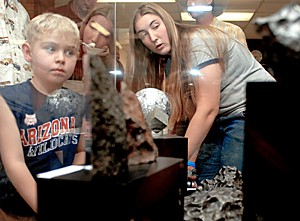Tin foil, rubber stamps and 3D glasses aren’t the first things that come to mind when one thinks about the planet Mars.
Yet all these things were on hand to help people understand Earth’s celestial neighbor at Saturday’s Mars Mania II, which celebrated the first batch of pictures returned by the UA’s High Resolution Imaging Science Experiment camera aboard the Mars orbiter.
Children and adults attended the event, which aimed to educate the public about the various missions to Mars, including the current $500-million Mars Reconnaissance Orbiter.
Various booths were set up where kids could build a soap-powered tin-foil rocket, maneuver tiny remote-controlled vehicles or see 3D images of the Martian surface, all while collecting stamps at each station for their “”Passport to Mars.””
The event was organized to coincide with the release of the eight Mars pictures by the $60-million HiRISE camera on March 23 and 25. Details of six of these pictures were on display at the event, said Loretta McKibben, information specialist coordinator at the Lunar and Planetary Laboratory.
The first Mars Mania was held last August to celebrate the launch of the MRO, McKibben said.
“”We have an obligation to tell the public about what we do,”” McKibben said. “”The public loves to learn about Mars.””
In addition to child-geared activities,
One of the best things we can do with NASA is to inspire an interest in math and science.
HiRISE principal investigator
there were lectures, educational displays and telescopes to satisfy the adults’ curiosity.
The telescopes in the Steward Observatory, Flandrau Planetarium and smaller ones set up on the UA Mall gave space enthusiasts a chance to see objects beyond Earth’s atmosphere.
Guests could even observe the sun safely during the daytime with a special hydrogen alpha telescope, said Paul Moss, a volunteer from the Tucson Amateur Astronomy Association.
“”Just look at the red ball and look at the surface of it, pretty soon it will look grainy,”” Moss said, instructing a visitor on how to see the sun’s details.
Local parents Marc and Toni LeBarge brought their young daughter to Mars Mania II because she had been studying the solar system in class.
“”It’s important they get exposed to science in a fun and provocative way,”” said Toni LeBarge, a Tucson resident.
She said it was nice for her daughter to see the planets and the stars she was studying first-hand, rather than just seeing pictures in a book.
Many of the parents and children attended the 3D show where they saw pictures from the Martian surface and an animation titled “”Six Minutes of Terror,”” aptly named to reflect the six minutes of radio silence NASA technicians endured during the 2004 Mars Opportunity rover landing.
Alfred McEwen, principal investigator for HiRISE, was also on hand to lecture on the camera aboard the MRO mission.
“”I think one of the best things we can do with NASA is to inspire an interest in math and science,”” McEwen said.
While the MRO spacecraft is aerobraking into a stable orbit around the Red Planet, the HiRISE team will be perfecting operation readiness and data retrieval to ensure a smooth mission, McEwen said.
“”When things go wrong in the mission, it means losing data,”” McEwen said.
The HiRISE camera, the most powerful telescopic camera sent outside Earth’s orbit, will return more than 34 terabytes of information within the mission’s first two years.
In fall 2006, the camera will begin mapping Mars and will be able to see individual boulders on the planet’s surface, aiding researchers in finding safe landing sites for future missions.
HiRISE is managed at the Charles P. Sonett Space Sciences building on campus.









